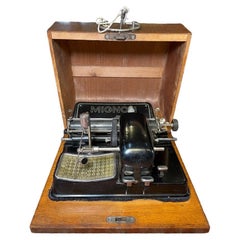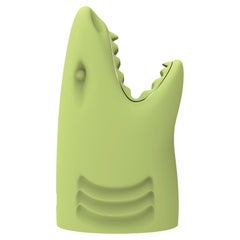Allgemeine Elektricitats-Gesellschaft Furniture
to
1
1
1
1
1
1
1
1
1
1
1
1
9,160
3,893
2,539
2,240
Creator: Allgemeine Elektricitats-Gesellschaft
German Mignon Portable Typewriter
By Allgemeine Elektricitats-Gesellschaft
Located in Guaynabo, PR
This is a German Mignon Typewriter. It was made by Allgemeine Elektricitats Gessellschaft. It depicts a black metal frame index typewriter machine attached to a hinged lidded box wit...
Category
20th Century German Industrial Allgemeine Elektricitats-Gesellschaft Furniture
Materials
Metal
Related Items
In Stock in Los Angeles, Green Killer Shark Mini Portable Charger
By Stefano Giovannoni
Located in Beverly Hills, CA
Killer shark mini power bank battery charger
In stock in Los Angeles
"Mr Holder was a shark who loved swimming but could not do it. He was mocked by all the other sharks who call...
Category
21st Century and Contemporary Italian Modern Allgemeine Elektricitats-Gesellschaft Furniture
Materials
Plastic
$23 Sale Price / item
64% Off
H 3.9 in W 2 in D 2 in
In Stock in Los Angeles, Purple Kong Mini Portable Charger
By Stefano Giovannoni
Located in Beverly Hills, CA
Kong mini power bank battery charger
In stock in Los Angeles
Easily transportable, Kong mini becomes a stand hugging the mobile phone and an external battery for fast charging mo...
Category
21st Century and Contemporary Italian Modern Allgemeine Elektricitats-Gesellschaft Furniture
Materials
Plastic
$23 Sale Price / item
64% Off
H 4 in W 4.5 in D 1.9 in
In Stock in Los Angeles, Pink Kong Mini Portable Charger
By Stefano Giovannoni
Located in Beverly Hills, CA
Kong mini power bank battery charger
In stock in Los Angeles
Easily transportable, Kong MINI becomes a stand hugging the mobile phone and an external battery for fast charging mo...
Category
21st Century and Contemporary Italian Modern Allgemeine Elektricitats-Gesellschaft Furniture
Materials
Plastic
$23 Sale Price / item
64% Off
H 4 in W 4.5 in D 1.9 in
Olivetti Lettera 36 Portable Typewriter Designed by Ettore Sottsass. circa 1970s
By Ettore Sottsass, Olivetti
Located in Miami, FL
Vintage Olivetti Lettera 36 Portable Typewriter with the Original Case. circa early 1970s
Created by famed Italian designer/architect Ettore Sottsass...
Category
1970s Italian Mid-Century Modern Vintage Allgemeine Elektricitats-Gesellschaft Furniture
Materials
Metal
$680
H 3 in W 13 in D 14 in
Antique English Victorian Hand Crank Mahogany Case Portable Upright Barrel Piano
Located in Philadelphia, PA
Antique English Victorian Hand Crank Mahogany Case Portable Upright Barrel Piano with Gold Gilt Trim. Circa Late 19th Century. Measurements: 45" H x 26" W x 18" D.
Category
Late 19th Century Unknown Other Antique Allgemeine Elektricitats-Gesellschaft Furniture
Materials
Wood
$3,200
H 45 in W 26 in D 18 in
Antique SABA RCR 405 Portable Cassette Radio
Located in Lisboa, Lisboa
SABA RCR 405 portable radio cassette. The device has a robust and functional design, with a rectangular structure in black and silver tones, accompanied by a top handle for easy tran...
Category
Mid-20th Century German Mid-Century Modern Allgemeine Elektricitats-Gesellschaft Furniture
Materials
Metal
Italian Typewriter "Olivetti Linea 88", Design Ettore Sottsass, 1966
By Olivetti, Ettore Sottsass
Located in Palermo, IT
Italian typewriter "Olivetti Linea 88", Design Ettore Sottsass, 1966
Good condition.
Features: Standard manual typewriter.
Keyboard: 46 keys, corresponding to 92 symbols.
Ribbon: 13...
Category
1960s Italian Vintage Allgemeine Elektricitats-Gesellschaft Furniture
Materials
Metal
$710
H 7.88 in W 17.33 in D 16.54 in
Vintage 1950s Hermes Rocket Typewriter
Located in Queens, NY
Vintage 1950s Hermes Rocket portable beige plastic typewriter with white square plastic keys and original matching beige plastic carry case
Category
20th Century Unknown Mid-Century Modern Allgemeine Elektricitats-Gesellschaft Furniture
Materials
Plastic
1950s Zenith Brown Bakelite Portable Radio Nonworking
By Zenith
Located in Chula Vista, CA
Vintage Zenith portable radio
9 h x 14.5 w x 8.75
Bakelite cover with rubber handle.
Original knobs. Minos scuffs present.
Tested and not working.
Review images listed.
Category
1950s Mid-Century Modern Vintage Allgemeine Elektricitats-Gesellschaft Furniture
Materials
Bakelite
In Stock in Los Angeles, Grey Kong Mini Portable Charger
By Stefano Giovannoni
Located in Beverly Hills, CA
Kong mini power bank battery charger
In stock in Los Angeles
Easily transportable, Kong MINI becomes a Stand hugging the mobile phone and a...
Category
21st Century and Contemporary Italian Modern Allgemeine Elektricitats-Gesellschaft Furniture
Materials
Plastic
$23 Sale Price
64% Off
H 4 in W 4.5 in D 1.9 in
American Mid Century Petite Portable Magnetic Chess Set Metal & Walnut
Located in San Diego, CA
A unique rare 1950's portable magnetic chess set walnut caze with metal board , very nice condition original box and instructions .
Category
20th Century American Mid-Century Modern Allgemeine Elektricitats-Gesellschaft Furniture
Materials
Metal
Underwood Vintage Manual Typewriter
By Underwood Universal
Located in Pasadena, TX
Underwood ” Vintage manual typewriter
The Underwood Typewriter Company was a manufacturer of typewriters headquartered in New Yor...
Category
1940s North American Industrial Vintage Allgemeine Elektricitats-Gesellschaft Furniture
Materials
Steel
Allgemeine Elektricitats Gesellschaft furniture for sale on 1stDibs.
Allgemeine Elektricitats Gesellschaft furniture are available for sale on 1stDibs.


